---------------------------------------------------------
When raising animals – either livestock or pets – it’s always going to be easiest to work with the animal’s natural instincts. You are not going to win a fight against nature, and it will make for happier animals!
When it comes to raising rabbits, many people keep them in separate cages where they live out nearly all their life solo. They are often only brought together for breeding or when raising young. The reasoning behind this method is to keep fighting and unwanted pregnancies to a minimum. While those are valid reasons, it goes against rabbit nature to live alone. It’s easiest for human caretakers to have them living solo, but rabbits are very social and want to live with other rabbits.
In the wild, rabbits live in large groups, called colonies. A wild colony could have anywhere from a few rabbits to a couple of dozen. They watch each other’s backs while grazing, practice social grooming, and snuggle together to keep warm in the winter.
When raising rabbits, they will be happiest if you can allow them the space and freedom to live in a colony. The colony can be set up in your yard, shed, barn, garage, basement, or spare bedroom. click here to read more about keeping indoor vs outdoor rabbits
Tips for working around the two biggest problems
Fighting
When rabbits are first introduced to the colony, you can expect there to be a little fighting. Introductions need to be done slowly. They need to establish where the new rabbit fits in the pecking order. Sometimes even existing colony members will fight to move up the ladder a bit during the upheaval of a new colony member.
The worst of this is usually over within a week, but it really just depends on your rabbits’ personalities. I have had rabbits take to each other instantly with zero fighting, and also some that took nearly a month before they could live peacefully together. Rabbits that have lived for a long time as solitary rabbits will have the hardest adjustment period. Kits that are born into the colony are pretty much just accepted with no fuss. click here to read more about introducing rabbits
The best thing you can do to keep fighting to a minimum is to give them lots of space. I recommend at least 20-30 square feet per rabbit. The more space they have to spread out, the less chance they have of getting on each other’s nerves! Also, be sure to provide lots of options for hiding. Small boxes large enough for 1-2 rabbits are great when they need to retreat for a little quiet time.
Bored rabbits are more prone to fighting. Keep your rabbits busy by giving them levels for jumping and areas for exploring. Tunnels intended for cats, or even just large PVC pipes provide entertainment. Rabbits also love to dig. Boxes filled with shredded paper or straw can provide hours of fun!
Another common reason for fighting is when they feel there are not enough resources. If you have a large colony, you will find providing multiple hay bins, and feed & water dishes will limit fighting.
Breeding
Rabbits are famous for their breeding skills. Left to their own devices in a colony setting you will be overrun with bunnies! A rabbit is typically pregnant for 30 days and can become pregnant again immediately after giving birth. They are induced ovulators which means the act of mating is what causes a female rabbit to ovulate. They can get pregnant at any time of the month or year. Rabbits also have a double-horned uterus, enabling them to get pregnant WHILE pregnant. They have no qualms about mating with their siblings, children, or parents and can mate as early as 10 weeks so you will need to separate the males & females by that point. With litter sizes up to a dozen, you can see how this can quickly get out of hand!
The setup of your colony will depend largely on your reasons for keeping rabbits.
Pet Colonies
Colony raising pet-only rabbits is super easy – you either just keep a single sex or you only keep rabbits that have been spayed or neutered. My female rabbits get along very well even though they are not spayed. When one has a litter of kits I have not had problems with the other females trying to hurt the babies, some even step in to act as “aunties” caring for the babies. Intact males have the highest likelihood of fighting, but without the presence of the other sex, they can often live together happily once they establish a “pecking order”.
I have several unaltered males in my buck colony. While I do have the occasional fight, it is almost always just a little chasing and maybe a little lost fur. 99.9% of the time my boys get along just fine, but of course every rabbit has their own personality. Some are just not suited to living in a colony. If you are not intending on breeding, I would recommend keeping all females or getting all your rabbits fixed.
Breeding Colonies
Raising rabbits for breeding, either for sale or for meat, requires a little more planning.
If you are raising rabbits for meat or sale and have a very high demand you can keep the bucks & does together full time. One buck can easily cover 10-15 does. If you have too many bucks, they could fight more often and overbreed the does. Keeping the males & females together all the time requires that you be ready to process or sell the rabbits regularly and pay careful attention to which rabbits live the most harmoniously together. The most docile should be kept to continue the colony.
The easier way to keep both male & female rabbits is to simply maintain two separate colonies. This allows you to control which pairs breed and how often. This is especially important when raising show rabbits. You only want to breed rabbits with the right characteristics to produce show-quality offspring.
I raise rabbits as pets & for their manure, but a couple of times per year I want to be able to breed them for sale or showing. Because I don’t want litters happening all year round, I have a doe colony and a buck colony. They have solid walls separating them so they can not see each other and each has its own outdoor area. When they can’t see each other it reduces the males fighting to “show off” for the females.
Other factors to consider when setting up your colony
Predators & the elements
An ideal place for a rabbit colony is a shed or barn outdoors or a spare bedroom indoors. This gives the rabbits lots of space to roam about while still being secure on all sides. click here to read about setting up a bunny barn – If possible, providing them with a secure, attached outdoor run is a great addition for exercise and fresh air. No matter what the setup, ensure the main walls are either solid or small gauge wire to prevent predators & rodents from getting in. The flooring should be solid to prevent predators from digging in and rabbits from digging out. The roof of the indoor section should be solid to keep out rain and snow. Be sure to provide predator-proof ventilation, especially in the summer. Heat is a much bigger threat to rabbits than cold. click here to read more about setting up an outdoor rabbit enclosure
General maintenance
Straw is an excellent product to use for bedding. They will have fun moving it around and making nests of it. Straw is a good nesting material and a good insulator for the winter months. My rabbit’s indoor area is in my barn which has concrete floors. To make it more comfortable, we put down heavy-duty foam floor tiles (like you would use under gym equipment). It is easy to sweep & mop clean. They have a corner with some straw for bedding and a few boxes with straw. Their outdoor area has a bottom covered with hardware cloth and we have scattered hay on top of it.
Feeding a large group of rabbits can sometimes be tricky. You need to make sure everyone is getting access to the feed and they aren’t overeating. click here to read my tips for feeding colony rabbits.
Rabbits are naturally clean animals and can be litter box trained. When your colony is litter-trained it really cuts down on cleaning chores! Click here to read more about litter training rabbits
Maintaining my rabbit colony is very easy. My male & female colonies each have a 110 square foot horse stall in the barn. Once a day I fill the feed, water, hay bins and bring them fresh produce. I sweep up any stray poop pellets that missed the litter box. A couple of times per week I dump the litter boxes into the compost. In the winter we add a bale of straw for them to snuggle into. click here to read more about my rabbit set up

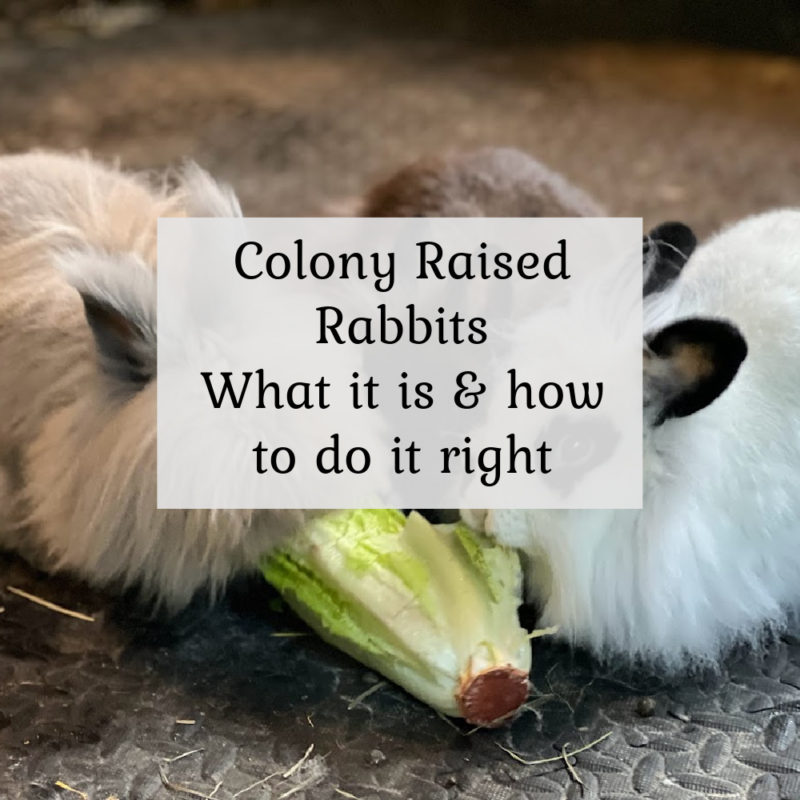

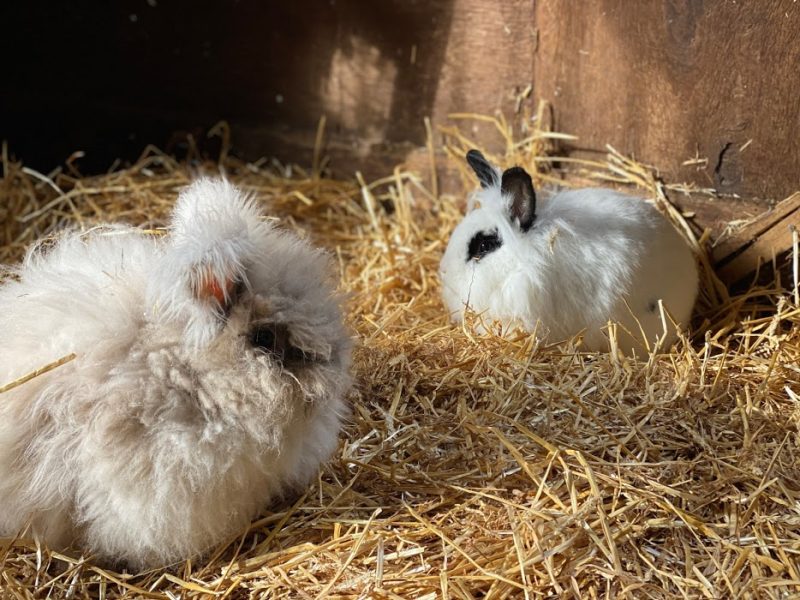
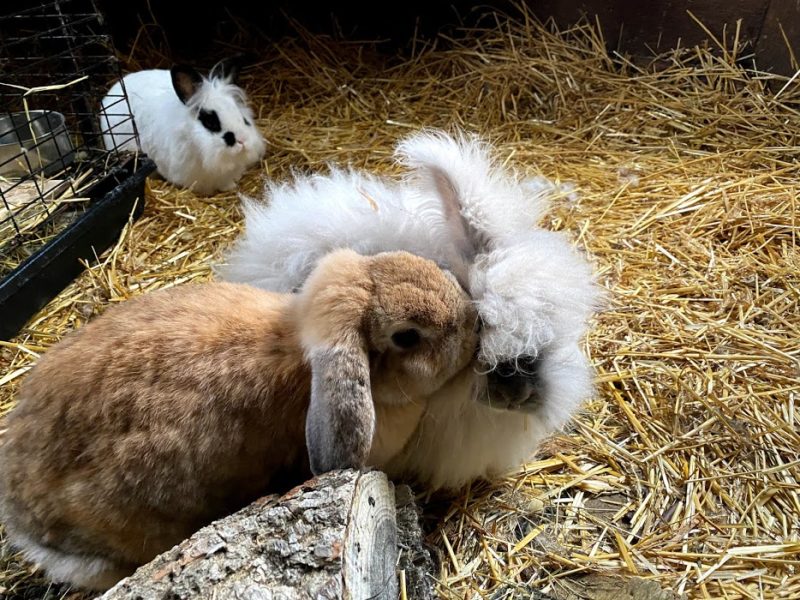

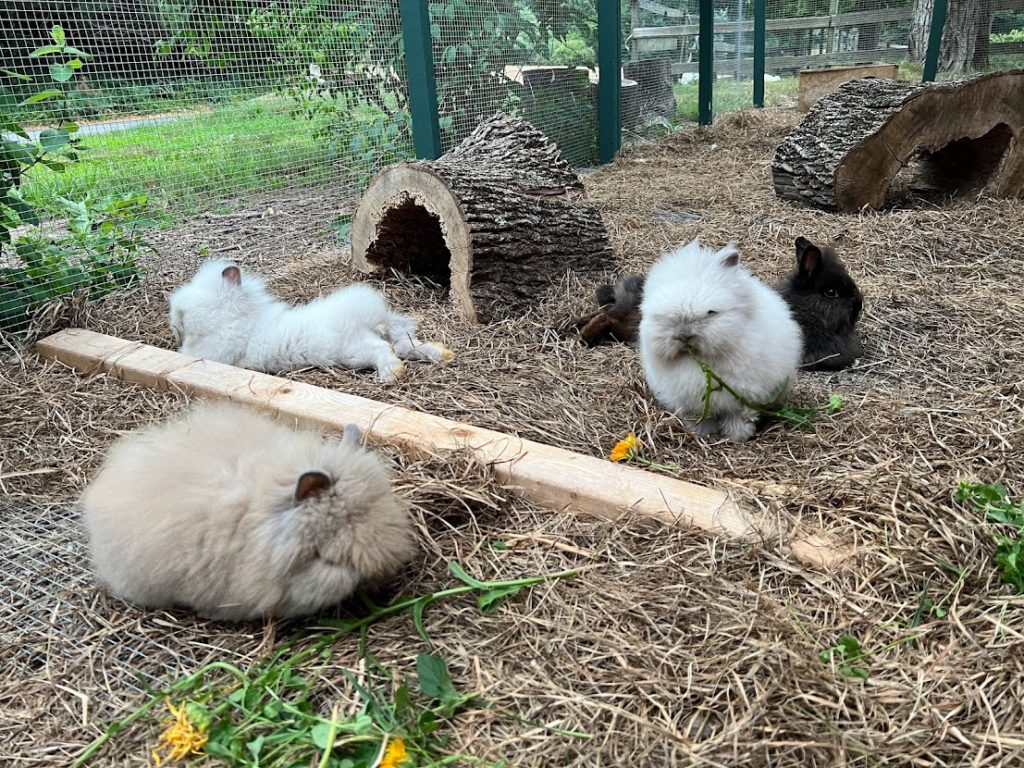
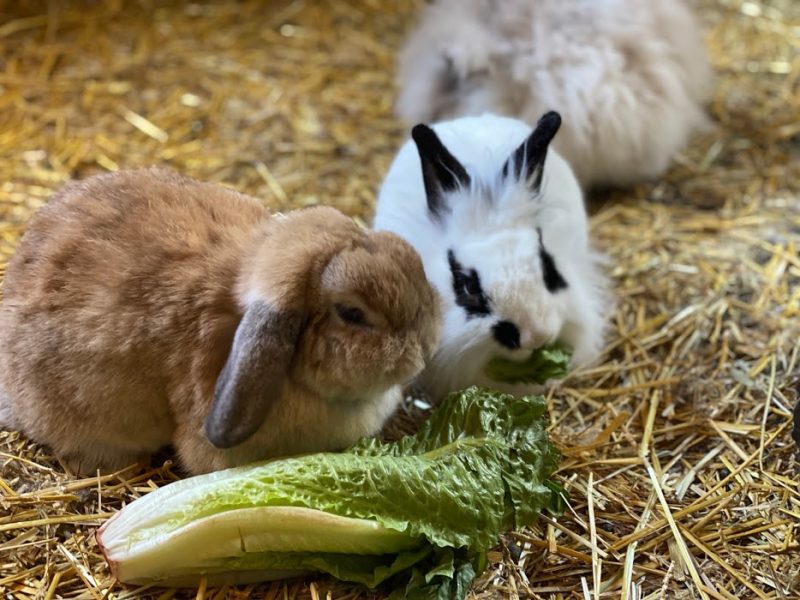
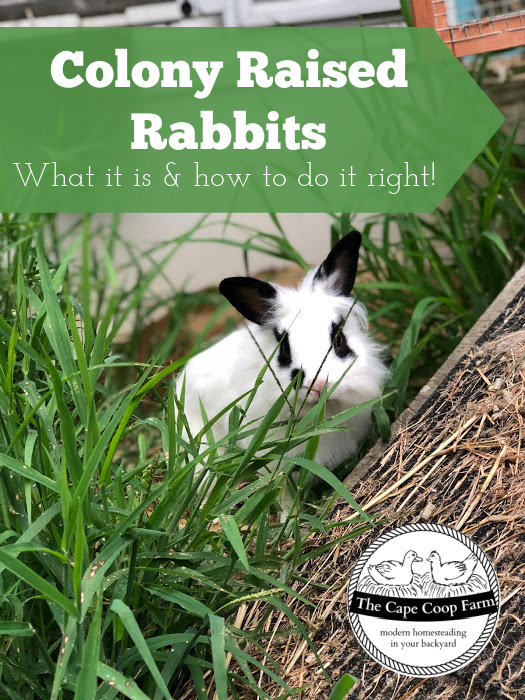



Aline
Monday 4th of March 2024
I have 1 male and 3 does in a 15ftx25ft enclosure outside. There is a 7'x10' covered area where they dig their tunnels. It is winter and snowing, and the last few weeks I have noticed the male hanging around outside the covered area in the snow by himself. I don't know if he is being chased out, if he is depressed, or if this is normal. There are a lot of offspring in the colony now, some are 2-4 months old, and I wonder if maybe young bucks are driving out the older male?
Liz
Tuesday 5th of March 2024
Hard to say, have you noticed any signs of fighting, like injuries or missing fur on the male? Have you seen any tufts of fur around the enclosure? It's possible he is going out there to get some peace. I have one male that retreats to spend more time alone when there are several kits nearing maturity (usually 3-5 months old). We have cameras in our enclosure so I can monitor that there isn't fighting, it's just his choice. But he usually comes around once the kits have moved on to their new homes, or once they have passed on to adulthood. I think he just doesn't like the "teenagers". Hopefully it's just a personality thing and he will come back around soon.
Hunter
Thursday 21st of September 2023
My desexed rabbits keep fighting when introduced. Do I just let them sort out the hierarchy? They have tons of space to ignore each other but choose to fight ending with blood and injuries.
Liz
Thursday 21st of September 2023
How are you introducing them? You might want to check out my article on introducing rabbits for some tips https://thecapecoop.com/introducing-new-rabbits/ To a certain extent you do need to let them work things out on their own, chasing is fine, small squabbles are fine, but I always draw the line at blood or injuries. They might just need more time living side by side. If it's been more then 5-6 months of them living side by side (where they can see & smell each other but can't get to each other) and they still are fighting to the point of drawing blood they might just be incompatable. Rabbits are just like humans, some are easy going, some are grouchy, some prefer to be alone. The majority of rabbits enjoy living with other rabbits, but there are always some that just hate other rabbits. Rescued rabbits especially might have a history of trauma before coming to you that might make them fearful of other rabbits. Just go slow and give them lots of time to get used to each other
Stephanie C
Saturday 15th of April 2023
If one in a colony of rabbit has babies, do the others help with nesting or hair pulling?
Liz
Sunday 16th of April 2023
I have never had other non-pregnant rabbits help with building the nest, but once the kits start to leave the nest area I have noticed the other female rabbits helping the babies find food, water, keeping them safe, and snuggling with them.
Shelly Westby
Saturday 30th of January 2021
I have a colony of about 30 rabbits. They are in a tuff shed with two play yards. I cut a hole on the end of the tuff shed so they two areas to hang out in. My question is about ground cover for both inside the tuff shed and in the play yards. Presently, I need to muck out the shed as it has layered up pretty high and is wet and smelly. I have benches in the shed that rabbits hide under and when the hay piles up it becomes a cave for them. I have been using wood pellets with a layer of wood chips on then hay on top. I throw a flake every night and whatever they don't eat becomes ground cover. It is rainy here, Washington state, but I want to much out the shed as I don't want them hanging out on the layers of wet and bunny pellets. Any suggestions? I have buried baby gates under the ground so they can't dig out as I have had that problem and have spent lots of days chasing rabbits. They are fast.
nancy oliver
Saturday 23rd of January 2021
Well that's a lot of great info! What you do with their fiber? Can you show some products at some point? Thanks
Liz
Monday 25th of January 2021
Thank you! Mostly I hang on to their fiber in hopes that someday I will have time to spin it lol. I've been working on learning to spin, it's a process. I have made some cute little needle felted critters with their fiber and that was fun!